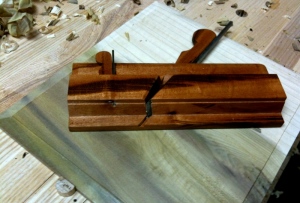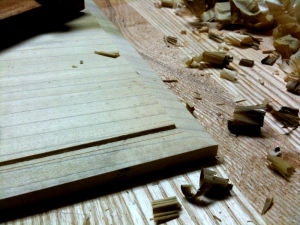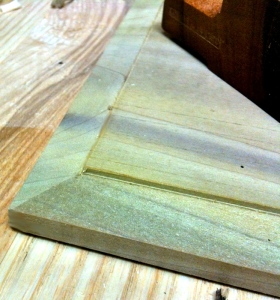Mini Panel Raising Plane
 I recently took delivery of a Mini Panel Raising plane made by Philly Planes. It was probably my recent Tool Cabinet build where I had to raise 9 drawer bottoms by hand to fit into the grooves in the drawer sides that pushed me over the edge into wanting to find a Panel Raising plane. The problem is that these planes are rare and VERY expensive in the wild. I searched for some time and just wasn’t willing to spend $350-800 on eBay for a vintage model that will need some restoration work. Then I remembered a blog post Phil Edwards wrote about his mini panel raiser. I placed my order and about 6 weeks later the plane was on it’s way to me from England.
I recently took delivery of a Mini Panel Raising plane made by Philly Planes. It was probably my recent Tool Cabinet build where I had to raise 9 drawer bottoms by hand to fit into the grooves in the drawer sides that pushed me over the edge into wanting to find a Panel Raising plane. The problem is that these planes are rare and VERY expensive in the wild. I searched for some time and just wasn’t willing to spend $350-800 on eBay for a vintage model that will need some restoration work. Then I remembered a blog post Phil Edwards wrote about his mini panel raiser. I placed my order and about 6 weeks later the plane was on it’s way to me from England.
 I got the plane last week and put it to work raising a small panel of Poplar. I did a true out of the box test and just inserted the nicker and skew iron and started planing. Phil recommends a quick honing but who among us can do that without at least giving the plane a test run. As an excuse to try out a new video streaming platform I actually recorded this test run live. I have embedded the recording below for those that are interested. A lot of the recording is me playing with the features of the streaming service but somewhere around the 4 min mark I actually get to raising a panel.
I got the plane last week and put it to work raising a small panel of Poplar. I did a true out of the box test and just inserted the nicker and skew iron and started planing. Phil recommends a quick honing but who among us can do that without at least giving the plane a test run. As an excuse to try out a new video streaming platform I actually recorded this test run live. I have embedded the recording below for those that are interested. A lot of the recording is me playing with the features of the streaming service but somewhere around the 4 min mark I actually get to raising a panel.
The plane is made from Goncalo Alves AKA Tigerwood. In the US we usually use this species as an exterior decking product. It is a South American hardwood that is very dense, heavy, stable, and oily. It makes for a good plane body that actually self lubricates in use. This is the second plane I have ordered from Phil and the Tigerwood handles the climate change from the UK to me on the East Coast of the US quite well. I can see possibly having to widen the mouth a tiny bit but I’m going to let the plane thoroughly acclimate before I do anything. It cuts nicely now but if I try to set the plane for a heavier cut the shavings will quickly clog the mouth.
 The plane has two irons. The first is a nicker that sets the vertical wall of the panel field. The second iron has a skewed aspect and cuts the bevel of the raised part. The skew makes for a clean cut both with and across the grain. I had the hint of a fuzzy edge on the hard line of the raised field when working across the grain, but this will be corrected by honing the iron as suggested in the accompanying instructions. The plane body serves double duty as a fence and a depth stop so this is a simple to use plane. Set your irons, and start planing until it stops cutting. Voila, a raised panel!
The plane has two irons. The first is a nicker that sets the vertical wall of the panel field. The second iron has a skewed aspect and cuts the bevel of the raised part. The skew makes for a clean cut both with and across the grain. I had the hint of a fuzzy edge on the hard line of the raised field when working across the grain, but this will be corrected by honing the iron as suggested in the accompanying instructions. The plane body serves double duty as a fence and a depth stop so this is a simple to use plane. Set your irons, and start planing until it stops cutting. Voila, a raised panel!
This is a mini panel raiser and is ideally designed for raising drawer bottoms or small door or cabinet panels. The total width of the bevel is about 3/4″ so on a panel over 4″ wide I think it looks too skinny and proportionally incorrect. So I plan to use this primarily as a tool to quickly raise drawer bottoms. I do have a small 4 panel door to build in the coming months and I will give it a try there to see how it looks.
Ultimately, it is a lot of fun to use and while there are other ways to raise a panel by hand, this dedicated plane makes it very quick and easy. Plus it is easy to sharpen since all the irons are straight edged. Phil has made another very valuable plane for my arsenal and I am yet again a happy customer. So much so that I have already commissioned another specialty plane from him. Phil will make pretty much anything you request but obviously true custom orders will run a higher price. I’m working with Phil now to hopefully introduce another plane into his “regular run” of products. More on that in the future. Thanks Phil for the great planes that you make.


